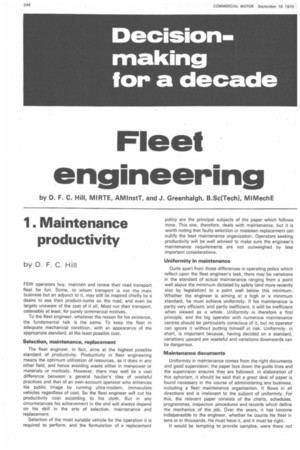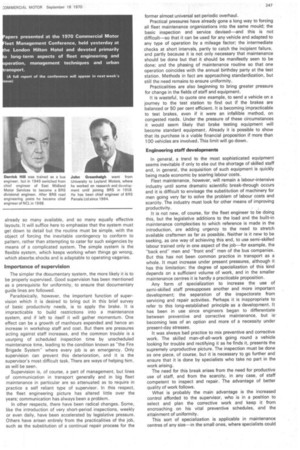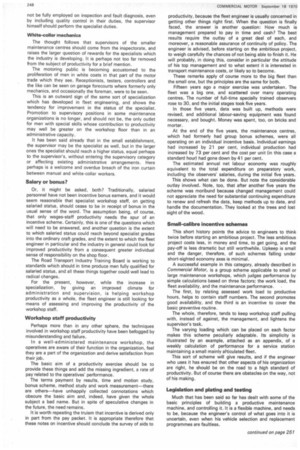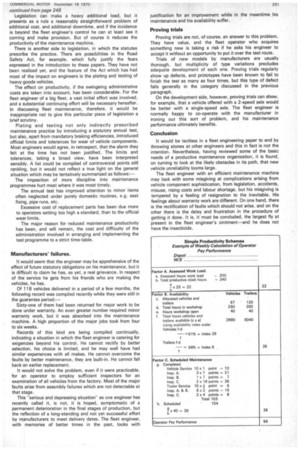Fleet engineering
Page 248

Page 249

Page 250

Page 253

If you've noticed an error in this article please click here to report it so we can fix it.
by D. F. C. Hill, MIRTE, AMInstT, and J. Greenhalgh, B.Sc(Tech), MIMechE
1. Maintenance productivity
by D. F. C. Hill
FEW operators buy, maintain and renew their road transport fleet for fun. Some, to whom transport is not the main business but an adjunct to it, may still be inspired chiefly by a desire to see their product-name on the road, and even be largely unaware of the cost of it all, Most run their transport, ostensibly at least, for purely commercial motives.
To the fleet engineer, whatever the reason for his existence, the fundamental talk is the same. To keep the fleet in adequate mechanical condition, with an appearance of the appropriate standard, at the least possible cost.
Selection, maintenance, replacement
The fleet engineer, in fact, aims at the highest possible standard of productivity. Productivity in fleet engineering means the optimum utilization of resources, as it does in any other field, and hence avoiding waste either in manpower or materials or methods. However, there may well be a vast difference between a general haulier's idea of wasteful practices and that of an own-account operator who enhances his public image by running ultra-modern, immaculate vehicles regardless of cost. So the fleet engineer will cut his productivity coat according to his cloth. But in any circumstances his achievement in the end will always depend on his skill in the arts of selection, maintenance and replacement.
Selection of the most suitable vehicle for the operation it is required to perform, and the formulation of a replacement policy are the principal subjects of the paper which follows mine. This one, therefore, deals with maintenance, but it is worth noting that faulty selection or mistaken replacement can nullify the best maintenance organization. Operators seeking productivity will be well advised to make sure the engineer's maintenance requirements are not outweighed by less important considerations.
Uniformity in maintenance
Quite apart from those differences in operating policy which reflect upon the fleet engineer's task, there may be variations in the standard of actual maintenance ranging from a point well above the minimum dictated by safety land more recently also by legislation) to a point well below this minimum. Whether the engineer is aiming at a high or a minimum standard, he must achieve uniformity. If his maintenance is partly very efficient, and partly inefficient, it willl be inefficient when viewed as a whole. Uniformity is therefore a first principle, and the big operator with numerous maintenance centres should be particularly conscious of it, but no operator can ignore it without putting himself at risk. Uniformity, in short, is important because, having decided on a standard, variations upward are wasteful and variations downwards can be dangerous.
Maintenance documents
Uniformity in maintenance comes from the right documents and good supervision; the paper lays down the guide lines and the supervision ensures they are followed. In elaboration of this aphorism, it should be said that a great deal of paper is found necessary in the course of administering any business, including a fleet maintenance organization. It flows in all directions and is irrelevant to the subject of uniformity. For this, the relevant paper consists of the charts, schedules, programmes, inspection procedures and records which define the mechanics of the job. Over the years, it has become indispensable to the engineer, whether he counts his fleet in tens or in thousands. He must have it, and it must be right.
It would be tempting to provide samples, were there not already so many available, and so many equally effective layouts. It will suffice here to emphasize that the system must get down to detail but the routine must be simple, with the object of forcing the inevitable contingency to conform to pattern, rather than attempting to cater for such exigencies by means of a complicated system. The simple system is the flexible system, which keeps working when things go wrong, which absorbs shocks and is adaptable to operating vagaries.
Importance of supervision
The simpler the documentary system, the more likely it is to be properly supervised. Good supervision has been mentioned as a prerequisite for uniformity, to ensure that documentary guide lines are followed.
Paradoxically, however, the important function of supervision which it is desired to bring out in this brief survey of basic productivity needs, is to apply the brake. It is impracticable to build restrictions into a maintenance system, and if left to itself it will gather momentum. One effect can be a growth of manhours expended and hence an increase in workshop staff and cost. But there are pressures acting against staff increases, and the common trouble is a usurping of scheduled inspection time by unscheduled maintenance time, leading to the condition known as "the Fire Brigade System" where every job is an emergency. Only supervision can prevent this deterioration, and it is the supervisor's most difficult task. There are ways of helping him, as will be seen.
Supervision is, of course, a part of management, but lines of communication in transport generally and in big fleet maintenance in particular are so attenuated as to require in practice a self reliant type of supervisor. In this respect, the fleet engineering picture has altered little over the years; communication has always been a problem.
In other respects, there have been radical changes. Some, like the introduction of very short-period inspections, weekly or even daily, have been accelerated by legislative pressure. Others have arisen entirely from the practicalities of the job, such as the substitution of a continual repair process for the former almost universal set periodic overhaul.
Practical pressures have already gone a long way to forcing all fleet maintenance organizations into the same mould; the basic inspection and service devised—and this is not difficult—so that it can be used for any vehicle and adapted to any type of operation by a mileage factor; the intermediate checks at short intervals, partly to catch the incipient failure, and partly because it is not only necessary that maintenance should be done but that it should be manifestly seen to be done; and the phasing of maintenance routine so that one operation coincides with the annual birthday party at the test station. Methods in fact are approaching standardization, but still the need remains to ensure uniformity.
Practicalities are also beginning to bring greater pressure for change in the fields of staff and equipment.
It is wasteful, to quote one example, to send a vehicle on a journey to the test station to find out if the brakes are balanced or 50 per cent efficient. It is becoming impracticable to test brakes, even if it were an infallible method, on congested roads. Under the pressure of these circumstances it would seem likely that brake testing equipment will become standard equipment. Already it is possible to show that its purchase is a viable financial proposition if more than 100 vehicles are involved. This limit will go down.
Engineering staff developments
In general, a trend to the most sophisticated equipment seems inevitable if only to eke out the shortage of skilled staff and, in general, the acquisition of such equipment is quickly being made economic by soaring labour costs.
Fleet maintenance, however, will remain a labour-intensive industry until some dramatic scientific break-through occurs and it is difficult to envisage the substitution of machinery for men going very far to solve the problem of labour costs and scarcity. The industry must look for other means of improving productivity.
It is not new, of course, for the fleet engineer to be doing this, but the legislative additions to the load and the built-in maintenance complexities to which reference is made in the introduction, are adding urgency to the need to stretch available craftsmen as far as possible. Neither is it new to be seeking, as one way of achieving this end, to use semi-skilled labour trained only in one aspect of the job—for example, the "back end" men and "front end" men of the bus companies. But this has not been common practice in transport as a whole, It must increase under present pressures, although it has this limitation: the degree of specialization of this kind depends on a sufficient volume of work, and in the smaller maintenance centres it is hardly a practicable proposition.
Any form of specialization to increase the use of semi-skilled staff presupposes another and more important development; the separation of the inspectorate from servicing and repair activities. Perhaps it is inappropriate to refer to this long-established principle as a development. It has been in use since engineers began to differentiate between preventive and corrective maintenance, but is' becoming less of an option and more of a necessity under present-day stresses.
It was always bad practice to mix preventive and corrective work. The skilled man-of-ail-work going round a vehicle looking for trouble and rectifying it as he finds it, presents the supremely unproductive picture. The inspection must be done as one piece, of course, but it is necessary to go further and ensure that it is done by specialists who take no part in the work arising.
The need for this break arises from the need for productive use of staff, and from the scarcity, in any case, of staff competent to inspect and repair. The advantage of better quality of work follows.
What is probably the main advantage is the increased control afforded to the supervisor, who is in a position to select and plan the corrective work and keep it from encroaching on his vital preventive schedules, and the attainment of uniformity.
This sort of specialization is applicable in maintenance centres of any size—in the small ones, where specialists could not be fully employed on inspection and fault diagnosis, even by including quality control in their duties, the supervisor himself should perform the specialist duties.
White-collar mechanics The thought follows that supervisors of the smaller maintenance centres should come from the inspectorate, and raises the larger question of rewards for the specialists which the industry is developing. It is perhaps not too far removed from the subject of productivity for a brief mention.
The motoring public is becoming accustomed to the proliferation of men in white coats in that part of the motor trade which they see. Receptionists, testers, controllers and the like can be seen on garage forecourts where formerly only mechanics, and occasionally the foreman, were to be seen.
This is an outward sign of the same sort of specialization which has developed in fleet engineering, and shows the tendency for improvement in the status of the specialist. Promotion to supervisory positions in some maintenance organizations is no longer, and should not be, the only outlet for men with special skills whose contribution to productivity may well be greater on the workshop floor than in an administrative capacity.
It has been said already that in the small establishment, the supervisor may be the specialist as well, but in the larger ones the specialist should reach a higher status, equal perhaps to the supervisor's, without entering the supervisory category or affecting existing administrative arrangements. Here perhaps is a welcome and overdue breach of the iron curtain between manual and white-collar workers.
Salary or bonus?
Or, it might be asked, both? Traditionally, salaried personnel have not been incentive bonus earners, and it would seem reasonable that specialist workshop staff, on getting salaried status, should cease to be in receipt of bonus in the usual sense of the word. The assumption being, of course, that only wages-staff productivity needs the spur of an incentive scheme. Certainly, this is one of the questions which will need to be answered, and another question is the extent to which salaried status could reach beyond specialist grades into the ordinary craft grades, and the extent to which the fleet engineer in particular and the industry in general could look for improved productivity from a consequent greater individual sense of responsibility on the shop floor.
The Road Transport Industry Training Board is working to standards which should in time produce men fully qualified for salaried status, and all these things together could well lead to radical changes.
For the present, however, while the increase in specialization, by giving an improved climate for administration and supervision, is helping workshop productivity as a whole, the fleet engineer is still looking for means of assessing and improving the productivity of the workshop staff.
Workshop staff productivity
Perhaps more than in any other sphere, the techniques involved in workshop staff productivity have been befogged by misunderstanding and failure.
In a well-administered maintenance workshop, the operatives are aware of their function in the organization, feel they are a part of the organization and derive satisfaction from their job.
The basic aim of a productivity exercise should be to provide these things and add the missing ingredient, a rate of pay related to the operatives' performance.
The terms payment by results, time and motion study, bonus scheme, method study and work measurement—there are others—have unhappily collected connotations which obscure the basic aim and, indeed, have given the whole subject a bad name. But in spite of speculative changes in the future, the need remains.
It is worth repeating the truism that incentive is derived only in part from the pay packet. It is appropriate therefore that these notes on incentive should conclude the survey of aids to productivity, because the fleet engineer is usually concerned in getting other things right first. When the question is finally faced, the answer is another question: How much is management prepared to pay in time and cash? The best results require the outlay of a great deal of each, and moreover, a reasonable assurance of continuity of policy. The engineer is advised, before starting on the ambitious project, to weigh carefully the chances of not being able to finish it. He will probably, in doing this, consider in particular the attitude of his top management and to what extent it is interested in transport maintenance costs, or likely so to become.
These remarks apply of course more to the big fleet than the small one, but the principles are the same for both.
Fifteen years ago a major exercise was undertaken. The fleet was a big one, and scattered over many operating centres. The number of full-time specially trained observers rose to 30, and the initial stages took five years.
In those five years, data was built up, methods were revised, and additional labour-saving equipment was found necessary, and bought. Money was spent, too, on bricks and mortar.
At the end of the five years, the maintenance centres, which had formerly had group bonus schemes, were all operating on an individual incentive basis. Individual earnings had increased by 21 per cent, individual production had increased by 73 per cent and the cost per unit (in this case a standard hour) had gone down by 41 per cent.
The estimated annual net labour economy was roughly equivalent to the total expenditure on preparatory work, including the observers' salaries, during the initial five years.
This shows what can be done. But note the considerable outlay involved. Note, too, that after another five years the scheme was moribund because changed management could not appreciate the need for substantial continuing expenditure to renew and refresh the data, keep methods up to date, and handle the documentation. They looked at the trees and lost sight of the wood.
Small-calibre incentive schemes
This short history points the advice to engineers to think twice before starting an ambitious project. The less ambitious project costs less, in money and time, to get going, and the pay-off is less dramatic but still worthwhile. Upkeep is small and the danger, therefore, of such schemes falling under short-sighted economy axes is minimal.
A successful example in this category, already described in Commercial Motor, is a group scheme applicable to small or large maintenance workshops, which judges performance by simple calculations based on three factors; the work load, the fleet availability, and the maintenance performance. • The first, by relating assessed work load to productive hours, helps to contain staff numbers, The second promotes good availability, and the third is an incentive to cover the basic preventive routine.
The whole, therefore, tends to keep workshop staff pulling with, instead of against, the management, and lightens the supervisor's task.
The varying loading which can be placed on each factor makes this scheme peculiarly adaptable. Its simplicity is illustrated by an example, attached as an appendix, of a weekly calculation of performance for a service station maintaining a small mainly articulated fleet.
This sort of scheme will give results, and if the engineer who uses it has ensured that other aspects of his organization are right, he should be on the road to a high standard of productivity. But of course there are obstacles on the way, not of his making.
Legislation and plating and testing
Much that has been said so far has dealt with some of the basic principles of building a productive maintenance machine, and controlling it. It is a flexible machine, and needs to be, because the engineer's control of what goes into it is uncertain, even when his vehicle selection and replacement programmes are faultless. Legislation can make a heavy additional load, but it presents as a rule a reasonably straightforward problem of additional cost, and additional downtime, and if the incidence is beyond the fleet engineer's control he can at least see it coming and make provision. But of course it reduces the productivity of the maintenance machine.
There is another side to legislation, in which the statutes prescribe the practice. There are possibilities in the Road Safety Act, for example, which fully justify the fears expressed in the introduction to these papers. They have not been realized yet, and the feature of the Act which has had most of the impact on engineers is the plating and testing of heavy goods vehicles.
The effect on productivity, if the swingeing administrative costs are taken into account, has been considerable. For the fleet engineer of a big fleet, a vast initial effort was involved, and a substantial continuing effort will be necessary hereafter. In discussing fleet maintenance, therefore, it would be inappropriate not to give this particular piece of legislation a brief scrutiny.
Plating and testing not only indirectly prescribed maintenance practice by introducing a statutory annual test, but also, apart from mandatory braking efficiencies, introduced official limits and tolerances for wear of vehicle components. Most engineers would agree, in retrospect, that the alarm they
felt at the time has not been justified. The limits and tolerances, taking a broad view, have been interpreted sensibly. A list could be compiled of controversial points still rankling, but it would not reflect a true light on the general situation which may be tentatively summarized as follows:—
The imposition of more discipline into maintenance programmes hurt most where it was most timely.
The annual test has improved attention to minor items often neglected under purely domestic routines, e.g. seat fixing, pipe runs, etc.
Excessive cost of replacement parts has been due more to operators setting too high a standard, than to the official wear limits.
The major reason for reduced maintenance productivity has been, and will remain, the cost and difficulty of the administration involved in arranging and implementing the test programme to a strict time-table.
Manufacturers failures.
It would seem that the engineer may be apprehensive of the effect of future statutory obligations on his maintenance, but it is difficult to claim he has, as yet, a real grievance. In respect of the service he gets from his friends who are making the vehicles, he has.
Of 118 vehicles delivered in a period of a few months, the following record was compiled recently while they were still in the guarantee period:—
Sixty-one of them had been returned for major work to be done under warranty. An even greater number required minor warranty work, but it was absorbed into the maintenance machine. A high proportion of the major jobs took from four to six weeks.
Records of this kind are being compiled continually, indicating a situation in which the fleet engineer is catering for exigencies beyond his control. He cannot rectify by better selection, his choice is limited, and he may well have had similar experiences with all makes. He cannot overcome the faults by better maintenance, they are built-in. He cannot fall back on earlier replacement.
It would not solve the problem, even if it were practicable, for an operator to employ sufficient inspectors for an examination of all vehicles from the factory. Most of the major faults arise from assembly failures which are not detectable at that stage.
This "serious and depressing situation" as one engineer has recently called it, is not, it is hoped, symptomatic of a permanent deterioration in the final stages of production, but the reflection of a long-standing and not yet successful effort by manufacturers to meet delivery dates. The fleet engineer, with memories of better times in the past, looks with justification for an improvement while in the meantime his maintenance and his availability suffer.
Proving trials
Proving trials are not, of course, an answer to this problem. They have value, and the fleet operator who acquires something new is taking a risk if he asks his engineer to accept it without an opportunity to put it over the test route.
Trials of new models by manufacturers are usually thorough, but multiplicity of type variations precludes adequate development of each one. Proving trials regularly show up defects, and prototypes have been known to fail to finish the test as many as four times, but this type of defect falls generally in the category discussed in the previous paragraph.
On the development side, however, proving trials can show, for example, that a vehicle offered with a 2-speed axle would be better with a single-speed axle. The fleet engineer is normally happy to co-operate with the manufacturer in ironing out this sort of problem, and his maintenance performance ultimately benefits.
Conclusion
It would be tactless in a fleet engineering paper to end by throwing stones at other engineers and this in fact is not the intention. Nevertheless, having reviewed some of the basic needs of a productive maintenance organization, it is found, on turning to look at the likely obstacles in its path, that new vehicle unreliability looms large.
The fleet engineer with an efficient maintenance machine may look with some misgiving at complications arising from vehicle component sophistication, from legislation, accidents, misuse, rising costs and labour shortage, but his misgiving is tempered by a feeling of resignation to the inevitable. His feelings about warranty work are different. On one hand, there is the rectification of faults which should not arise, and on the other there is the delay and frustration in the procedure of getting it done. It is, it must be concluded, the largest fly at present in the fleet engineer's ointment—and he does not have the insecticide.






























































































































































































































































































































































































